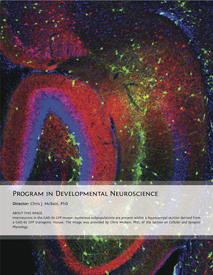You are here: Home > Program in Developmental Neuroscience
Program in Developmental Neuroscience
Director: Chris J. McBain, PhD
The Program in Developmental Neuroscience (PDN) takes a comprehensive approach to the study of developmental neuroscience by using techniques of neurophysiology, molecular and cellular biology, crystallography, and imaging. Overall, the research focuses on the development, physiology, and pathophysiology of the mammalian central nervous system. Researchers study receptors, ion channels, and cellular and synaptic signaling mechanisms in preparations that range from isolated proteins and cells to highly ordered neural networks in physiological and pathophysiological conditions observed in both wild-type and numerous transgenic animals.
Tamás Balla's Section on Molecular Signal Transduction investigates the role of phosphoinositide-derived messengers in mediating the actions of hormones, growth factors, and neurotransmitters in mammalian cells. The Section studies the cellular functions of phosphatidylinositol 4-kinase (PI4K) enzymes that regulate the first committed step in phosphoinositide synthesis. Over the last year, the Section developed a new method for rapidly eliminating PtdIns4P selectively from Golgi membranes and showed that exit of various cargoes from the Golgi was blocked once PtdIns4P was removed. Collaborative studies visualized, for the first time, the contact zones between the mitochondria and endoplasmic reticulum and the local calcium ion concentration in these microdomains. The Section was also involved in studies that showed PI4K type-IIIbeta to be critical for the replication of small RNA viruses such as polio- and coxsackievirus, opening new possibilities to fight these viral infections.
Dax Hoffman's Molecular Neurophysiology and Biophysics Section continues to investigate the role of the voltage-gated potassium channel subunits in the regulation of dendritic excitability and synaptic integration of hippocampal neurons. Over the past year, the Unit discovered that distance-dependent dendritic mobility of the K+ channel subunit Kv4.2 is regulated by activity-dependent phosphorylation of Kv4.2 by protein kinase A (PKA). The source of PKA modulation was identified as a novel accessory subunit for Kv4.2A, AKAP79/150, which provides a platform for dynamic PKA regulation of Kv4.2 expression, critically affecting neuronal excitability. Studies in heterologous expression systems showed that Kv4 a-subunits interact with an additional auxiliary subunit, DPP6, which was recently identified in large copy-number variant screens as a target gene for autism spectrum disorder and amyotrophic lateral sclerosis. In dendritic recordings from DPP6 knockout mice, the laboratory discovered that DPP6 is critical for generating the A-type potassium current gradient observed in CA1 dendrites. Loss of this gradient led to hyper-excitable dendrites, with implications for information storage and coding.
Kuo-Ping Huang's Section on Metabolic Regulation investigates the signaling mechanisms involved in synaptic plasticity. Using neurogranin (Ng) knockout mice, the Section demonstrated the protein's critical role in the expression of long-term potentiation and normal cognitive function. Environmental enrichment and treatment with Ritalin ameliorated the behavioral impairments of young adult Ng-knockout mice.
Y. Peng Loh's Section on Cellular Neurobiology explores the mechanisms of intracellular trafficking and secretion of peptide hormones, neuropeptides, and neurotrophins in endocrine cells and neurons as well as the role of the prohormone-processing enzyme carboxypeptidase E in stress, neuroprotection, and tumorigenesis. Major accomplishments over the past year include: establishing the role of serpinin, a novel secreted chromogranin A–derived peptide, in regulating dense-core secretory granule biogenesis through a cAMP-PKA-sp1 pathway, in an autocrine manner, in pituitary corticotrophic cells; elucidating the mechanism of action of a novel splice isoform of carboxypeptidase E in promoting tumor metastasis; and demonstrating that the isoform is a powerful biomarker for predicting metastasis in hepatocellular carcinoma and pheochromocytoma patients.
Chris McBain's Section on Cellular and Synaptic Physiology investigates the development and regulation of cortical excitability, in particular glutamatergic and GABAergic synaptic transmission and plasticity in the hippocampal formation. The Section investigates mechanisms underlying the differential regulation of transmitter release at functionally divergent presynaptic terminals along a common axon, the roles of ionotropic and metabotropic glutamatergic and cholinergic receptors in controlling cell excitability, and bi-directional synaptic plasticity at both inhibitory and excitatory axon terminals.
Stanko Stojilkovic, who heads the Section on Cellular Signaling, and colleagues investigate signaling pathways in pituitary cells. They characterized the role of multidrug-resistance proteins 4 and 5 in cyclic nucleotide efflux and the dependence of these transporters on membrane potential in cultured pituitary cells. In related studies, they investigated the role of calmodulin kinase II in stimulus-secretion coupling as well as the role of prostaglandins in autoregulation of GnRH receptors. They also characterized the molecular, pharmacological, and functional properties of P2X4 receptor channels in normal and immortalized pituitary cells and their roles in electrical activity, calcium signaling, and secretion. The Section showed that heavy metals and reactive oxygen species are allosteric modulators of P2X2 receptor channels, cloned from the pituitary gland.
Mark Stopfer's group, the Section on Sensory Coding and Neural Ensembles, is interested in how the brain gathers and organizes sensory information to build transient and sometimes enduring internal representations of an animal's surroundings; the animal actively collects information, which is then processed and dramatically transformed in myriad ways. The Unit's goal is to understand the mechanisms by which sensory information is collected, transformed, stabilized, and compared as it makes its way through the nervous system. Using relatively simple animals and focusing primarily on olfaction, the Unit combines electrophysiological, anatomical, genetic, behavioral, computational, and other strategies to examine how fully intact neural circuits, driven by real sensory stimuli, process information.


